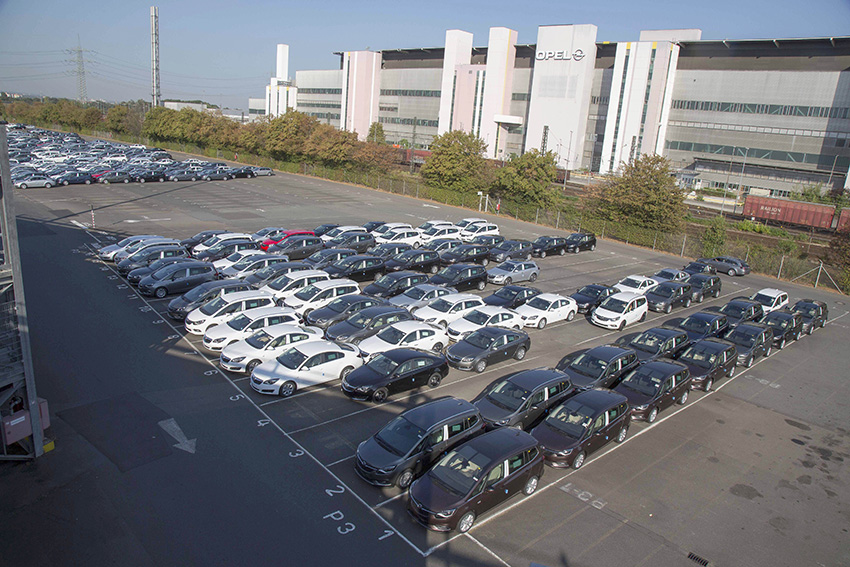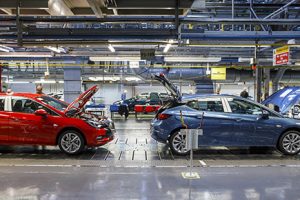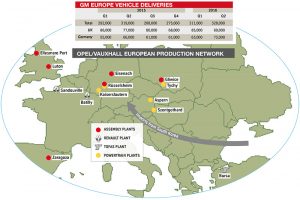 Following a period of transformation and improvements in production planning, Opel is on a product offensive. Director of logistics Andreas Graffe and outbound logistics manager Michael Gorny discuss the importance of ‘frontloading’ logistics to support it.
Following a period of transformation and improvements in production planning, Opel is on a product offensive. Director of logistics Andreas Graffe and outbound logistics manager Michael Gorny discuss the importance of ‘frontloading’ logistics to support it.
In this story...
[sta_anchor id="1"]In many ways, the supply chain has played a key role in GM’s European transformation. While many of its recent manufacturing and sales decisions were taken for broader financial reasons, they have had a direct impact on logistics and vehicle distribution, whether plant closures or ending sales in certain markets.
Other moves, meanwhile, have been made more specifically with logistics and supply chain efficiency in mind. For example, when GM and PSA established an alliance in 2012, a key plank of the agreement was for the French carmaker’s then in-house logistics provider, Gefco (now majority owned by RZD Russian Railways), to take over GM’s inbound and outbound logistics in Europe as a fourth party logistics provider (4PL). GM turned to Gefco in part to increase its scale across the continent, notably to create synergies across Gefco’s pool of clients, including PSA, with the goal of lower freight costs, reduced waste and higher transport utilisation.
Opel’s logistics executives also point to improved collaboration across the company when making decisions that affect the supply chain, including more ‘frontloading’ of logistics, such as planning early in the development phase of a new vehicle entry, and interacting with other departments in the corporation from design right through to distribution.
Andreas Graffe, who took over as director of logistics for Opel/Vauxhall this past April, says this approach has matured significantly at the carmaker. For example, vehicle distribution is now less of an afterthought and takes a more strategic role.
“Outbound is getting more involved and playing a bigger role in manufacturing, footprint and launch decisions,” says Graffe. “We’re ensuring that within Opel/Vauxhall we are becoming more sensitive to logistics impacts.”

He points to changes across the production network that the logistics department had an important hand in shaping. The Mokka crossover SUV, previously imported to Europe from South Korea, was localised at Opel’s plant in Zaragoza, Spain to provide more build capacity for the popular vehicle; the move resulted in a major logistics project that helped decrease lead times to European customers.
Last year, GM also began assembly of the new Astra at Ellesmere Port in the UK, the carmaker’s largest sales market in Europe; the model is also manufactured at Opel’s plant in Gliwice, Poland, allowing Opel/Vauxhall more flexible distribution depending on customer locations.
Such moves require careful logistical analysis, both in understanding potential outbound costs to customers as well as in shipping inbound components. The Mokka decision, for example, needed to balance a shorter outbound lead time with increased import of production parts from Asia, which required a bespoke logistics solution. New outbound transport lanes and vehicle handling capacity also needed to be created for the Spanish plant.
According to Michael Gorny, who worked on expanding logistics capacity in Zaragoza before he was appointed outbound logistics manager for Opel/Vauxhall last year, the outbound logistics team now starts planning the specific vehicle distribution strategy for a smooth market introduction of any new product two years prior to a vehicle launch, alongside departments such as sales, marketing and programme management.
What is more, the planning of logistics requirements for new vehicle programmes often starts as much as five years in advance, including for critical inbound logistics needs.
While outbound typically comes later, Gorny says vehicle logistics considerations form an equally important part in carmaker’s total enterprise cost process, which analyses the full cost, risks and benefits across all decisions.
“As well as influencing location and manufacturing decisions, the earlier planning is also essential in allowing Opel to build the necessary outbound network, including establishing transport modes and capacity at distribution compounds,” he states.
 Andreas Graffe: outbound logistics is getting more involved and playing a bigger role in manufacturing, footprint and launch decisions
Andreas Graffe: outbound logistics is getting more involved and playing a bigger role in manufacturing, footprint and launch decisionsAndreas Graffe points to Gefco as also having an important role to play in this planning, referring to the 4PL as GM’s “logistics support and logistics analysis arm” in Europe. Opel benefits from Gefco’s role in understanding and predicting costs, he says, while the transitioning of day-to-day management and operations has allowed Opel’s logistics to focus more on long-term strategies.
“The relationship is progressing and we are still learning how we can best work together, but Gefco does change aspects of what we are working on in logistics,” says Graffe. “We are more focused on planning ahead, including new product launches, footprint changes and total cost analysis.”
[sta_anchor id="2"]Amidst the upheaval, stability in the supply chainOpel/Vauxhall’s supply chain has certainly been subject to a number of major shifts as part of a plan to return GM to profitability in Europe this year for the first time since 1999. It is a challenging path that has shown particular progress of late as Opel/Vauxhall sales have been on the rise in 2016 even despite the end of Russian operations in 2015. GM’s second quarter report this year also revealed that the carmaker recorded a $131m profit in Europe in the first six months.
While improvement in plant utilisation and the European sales market are most important, the closer connectivity between Opel’s logistics, production, sales and finance teams, among others, has played a role in improving the company’s productivity and strategic decision-making. That seems likely to become more important both in the face of an upcoming product onslaught – Opel/Vauxhall is planning to introduce 29 new models between this year and 2020 – but also as further upheavals cannot be ruled out in Europe.
Britain’s vote to leave the European Union in June, for example, has set the country and the EU on an unchartered course, the impacts of which are far from clear for the automotive industry – from short-term currency shifts, to long-term trading terms.
 Michael Gorny: outbound logistics team starts planning vehicle distribution strategy for any new product two years prior to a vehicle launch
Michael Gorny: outbound logistics team starts planning vehicle distribution strategy for any new product two years prior to a vehicle launchGraffe and Gorny say it is too soon for Opel/Vauxhall’s logistics department to comment on potential changes or impacts from Brexit on the supply chain. Nevertheless, understanding what any economic and regulatory changes could mean for the OEM’s supply chain – whether something as major as the introduction of tariffs, or as relatively small as new road tolls in Belgium – will require close consideration of logistics and trading conditions.
However, despite all the change across Opel/Vauxhall’s footprint and strategy in recent years, and even considering questions about the future, it would be wrong to think that Opel/Vauxhall’s logistics and supply chain have been suffering from whiplash as a side effect. On the contrary, its logistics operations have entered a new phase of stability thanks in part to production and process improvements, while Opel is also testing and planning a number of technologies and applications that could benefit outbound logistics even further.
For the supply chain, stability has come from projects related to each facet of the organisations to which logistics belongs and its related departments. Regionally, for example, Graffe and his logistics department report to Kathy Worthen, vice-president of global purchasing and supply chain (GPSC) for GM Europe. Within GPSC in Europe, which includes purchasing, logistics, supply chain operations and production scheduling, among other functions, the carmaker has made particular strides in improving cross-functional teamwork. That has included efforts to make production schedules more accurate and reliable, and sharing that information with suppliers and with logistics providers.
Opel/Vauxhall’s logistics is also part of GM’s global logistics and containerisation organisation, led by executive director Edgard Pezzo in Detroit, to whom Graffe also reports. Here, too, global efforts to enhance IT systems and connectivity across the company and the logistics chain have improved transport visibility, including technology to share more information in real time. For example, Opel is now trialling RFID tags for vehicle yard management at its plant in Eisenach, Germany; in future, the use of digital technology within vehicles and across supply chain providers is expected to bring this connectivity to an entirely new level globally.
[sta_anchor id="3"]Slotting in advanced planningPerhaps most notable on Opel’s path to supply chain stability and connectivity has been a new order scheduling process, called ‘order slotting’, that has been rolled out across all the carmaker’s plants over the last two years.
Order slotting has helped to create a real-time connection between vehicle orders and material supply for General Motors’ European production. The system, which won the top logistics award in 2015 from the VDA, Germany’s national automotive association, uses software developed by German IT expert Flexis with an in-memory database to integrate the vehicle order management with production and material planning.
The software has been combined with the creation of cross-functional teams across Opel/Vauxhall, including order management, logistics, material follow up, manufacturing and sales, to monitor and react to changes in orders (including as ‘forecast’ orders become customer orders) and material availability. The approach helps Opel/Vauxhall to adjust its order sequence based on real-time supply pipelines and ultimately to create more reliable production schedules for suppliers, and inbound and outbound logistics providers.
 Delivery figures and network map – click to enlarge
Delivery figures and network map – click to enlargeFew appreciate the significance of the new process and its impacts for logistics as well as Andreas Graffe, a 20-year GM veteran who has worked across GPSC functions in Europe and in China. He first took the helm of Opel/Vauxhall’s logistics department in 2011, before moving to lead order, production scheduling and capacity management. There he was instrumental in implementing order slotting and in helping to establish the inter-departmental teams essential to its success. Now, back in logistics, his team is both participating in the real-time monitoring of supply and orders, as well as benefitting from the levelled-production that the processes have helped to reinforce.
Graffe explains that the primary process of order slotting rests more in order management and supply chain operations than in outbound logistics, but that its success benefits vehicle distribution. “Order slotting has enhanced our ability to create more stability in our plants, the benefits of which we are now applying to outbound logistics, with advanced transport planning for carriers,” says Graffe.
With a more stable production, Opel is striving to provide more reliable final delivery dates for its end customers. “For outbound, our focus must be on the customer,” says Michael Gorny. “Order slotting helps us to do what we say we are going to do in terms of sticking to committed delivery dates. It also helps us to reduce order-to-delivery times.”
Importantly, this improved production sequence stability is shared with outbound providers. The goal is to consider truckloads when planning the production sequence, as well as to use pipeline data to plan finished vehicle load sequences in advance with carriers.
 "Order slotting helps us to do what we say we are going to do in terms of sticking to committed delivery dates. It also helps us to reduce order-to-delivery times." - Michael Gorny, Opel/Vauxhall
"Order slotting helps us to do what we say we are going to do in terms of sticking to committed delivery dates. It also helps us to reduce order-to-delivery times." - Michael Gorny, Opel/Vauxhall
Opel’s usual process is that it signals outbound carriers to pick up a vehicle once it comes off the assembly line and is transferred from the plant to the sales organisation. At that point, logistics providers have 48 hours to pick up vehicles from the plant yard. While the flow works effectively, especially for larger volumes, loads are created based only on what has been built. That means inventory must sit before full truckloads are available. At the same time it can create delays as a result of poor visibility of what might be coming off the assembly line.
For example, it could be that eight cars out of a nine-car truckload destined for one particular delivery destination in Europe have been built early in the week, while the last vehicle is built at the end of the week; as a result, the cars built earlier end up waiting three or four extra days until the last car is available before they can all be called off to the carrier. If production of the last car is changed, they could wait even longer.
 With more stable order plans, Opel is running a trial where carrier pickups will be based on production schedule information up to five days before a vehicle is built, rather than giving carriers notice only once it comes off the assembly line
With more stable order plans, Opel is running a trial where carrier pickups will be based on production schedule information up to five days before a vehicle is built, rather than giving carriers notice only once it comes off the assembly lineBy using sequence stability in the plants, Opel is able to optimise the production schedule according to its outbound needs. As that sequence is more stable, logistics can rely on the car being built when planned. The process allows trucks to be dispatched more quickly and frees up space in the plant yard.
Opel is also trialling an increase in the lead time for collection it offers to carriers by calling off their loads based on planning data rather than waiting for the handover to sales. Truckloads could be pre-arranged based on the production sequence, with carriers given notice up to five days in advance of completed assembly. In that case, logistics providers’ trucks would be available based on when all of the vehicles come off the line. This advanced planning could allow for earlier truck dispatches, with considerable reductions in standing inventory and a faster, more reliable delivery date for customers.
Such a process resembles an outbound logistics version of the Perlenkette (pearl chain), or long distance just-in-sequence delivery. This refers to when a supplier based far away builds and packs its product based on a planned production sequence from the OEM, delivering it straight to the assembly line with minimal storage time. Just as with such inbound processes, advanced outbound planning depends on the “absolute process discipline of all parties involved,” says Graffe. In that way, yard operators and carriers need to rely on the sequence to plan their assets around the pipeline, rather than existing inventory.
This advanced notification for carriers is still in a testing phase, though early indications are positive, and Graffe believes that a wider rollout will bring benefits. For it to succeed, however, there must be consistency and communication across the supply chain.
“It is so important to build the discipline to manage the order and production system,” Graffe says. “The point is to have different cross-functional teams that are all looking at the same data. That includes having regular meetings across departments to make joint decisions on what order to change or build based on the material availability and on logistics.”
As outbound logistics planners are not directly involved in determining order sequences (these are based more on material availability and inbound schedules), the distribution team needs to be closely aligned to order and production data. Graffe says the outbound team has access to this information and makes decisions based on it.
In future, however, there could also be scope for vehicle destinations to play an even greater role in determining production sequences, particularly for batching together lower volume destinations to build designated transport loads. Locations already play some role when establishing sequences, though material availability and supply tend to be more significant.
“We wouldn’t want to build a silo in our order sequence around outbound, but ideally we could do more to influence production scheduling based on destinations,” says Graffe.
[sta_anchor id="5"]Launching a flexible networkImprovements in production and supply chain stability, as well as better collaboration across management functions, have helped Opel/Vauxhall make necessary changes in its supply chain as it has realigned production in line with demand. In Europe, GM has invested heavily into new products across its plants and dealer network. Both production and logistics capacity will be tested further over the next five years during the most ambitious spate of model launches in Opel/Vauxhall’s history.
The company has already had a number of successful launches that required significant logistics adjustments. The allocation of Mokka to Spain, which has wide distribution across Europe, led to increases in both rail flows to ports and elsewhere in Europe, as well as short-sea shipping to destinations such as the UK. This network is now well established in time for the launch of the new Mokka X, which started production in Zaragoza at the end of August.
 Opel uses a GM distribution management system that has been adapted for European purposes to monitor vehicle movements from plant to final delivery
Opel uses a GM distribution management system that has been adapted for European purposes to monitor vehicle movements from plant to final deliveryAdding the new Astra to Ellesmere Port and Gliwice was also positive for logistics, according to Michael Gorny. “Launching our latest Astra model was a very good experience, which included smooth processes and collaboration with our carriers,” he says. “Considering this, we are confident and well prepared for upcoming challenges.”
Just recently the new version of the Zafira compact van in Rüsselsheim was also launched, with other model entries and production starts underway across the continent.
As part of the alliance agreement with PSA, both carmakers’ plants will be launching a number of cross-production projects, including a Citroën van in 2017 alongside the next generation Opel Meriva van in Zaragoza.
Although Opel has focused most of its production capacity in Europe, it also has an extended international network, including imports from South Korea. The Opel/Vauxhall Karl compact hatchback, for example, has been imported from GM’s plant in Changwon, South Korea since 2015, while the carmaker still relies on GM’s plant in Bupyeong for extra capacity of the Mokka X. Opel has also announced that next year it will launch the Opel Ampera-e in Europe, a new vehicle that makes electromobility feasible for more everyday drivers.
Some flows go the other way, too. Last year, Opel started shipping the Buick version of the Opel Cascada to North America from its plant in Gliwice. Exports to South Africa have also been launched over the past two years.
 "It is so important to build the discipline to manage the order and production system. The point is to have different cross-functional teams that are all looking at the same data. That includes having regular meetings across departments to make joint decisions on what order to change or build based on the material availability and on logistics." - Andreas Graffe, Opel/Vauxhall
"It is so important to build the discipline to manage the order and production system. The point is to have different cross-functional teams that are all looking at the same data. That includes having regular meetings across departments to make joint decisions on what order to change or build based on the material availability and on logistics." - Andreas Graffe, Opel/Vauxhall
In view of such dynamic flows, Opel/Vauxhall, together with Gefco, has a large, flexible outbound network across Europe, which includes vehicle-handing yards at its six assembly plants – plus Renault plants in France and Fiat-Tofas in Turkey which build Opel/Vauxhall vans – as well as dozens of rail ramps, ports and vehicle distribution compounds.
Overall, however, the shape of the outbound network is relatively stable. Opel’s overall transport split for finished vehicle distribution has not changed much overall even after developments in Spain and other changes to its production footprint. According to Gorny, truck transport is still the largest mode, at more than 50% of outbound volume across Europe. The reason is partly because of a high share of multimodal transport.
“We use a lot of rail and vessel and that will also likely grow, but most of our deliveries are combined of two modes or more, with vehicles always touching a truck for at least final delivery,” Gorny says.
Broadly speaking, Opel and Gefco review the network regularly to make sure vehicle flows remain efficient and that market or regulatory conditions don’t require new solutions, such as different import hubs or equipment.
 Opel and Gefco are continually evaluating the main supply lines and will take a wider look at the network every two or three years
Opel and Gefco are continually evaluating the main supply lines and will take a wider look at the network every two or three years“We are continually evaluating the main lines, but if a pick-up and drop-off location is fixed and volumes are relatively consistent, we don’t need to spend all of our time looking at it,” says Gorny. “Strategically, we take a wider look at the network every two or three years, although that can be done more frequently [when] triggered by other changes as well.”
He points to the recent introduction of a road toll in Benelux as an example that requires new considerations for transport and distribution, and potentially different transport modes or routes.
The upcoming model campaign over the rest of the decade is also prompting Opel to review its network further and to prepare for more adjustments, while challenging Opel and Gefco to ensure carriers are ready with sufficient capacity and service to meet delivery promises.
“The new product entries will result in changes to our network,” says Gorny, who has worked on the logistics-related launches of several new vehicles and powertrain products since joining Opel in 2008. “As logistics we will work with purchasing, sales, manufacturing, finance and other stakeholders internally, as well as with suppliers and service providers externally, to position ourselves in such a way as to make sure logistics cost and timing aspects are captured.”
[sta_anchor id="6"]Capacity through efficiencyThe coming launches will require securing sufficient capacity for vehicle logistics while avoiding imbalances across the network. Andreas Graffe describes each launch as a “repeating lesson”, with a chance to learn from plants and logistics providers and apply previous experience to better processes.
“The challenge is, within the start-up phase, to manage a huge amount of additional logistics capacity without increasing cost, avoiding any negative impact to partners and, above all, meeting promised customer dates,” he says.
Such capacity management will be particularly important for Gefco as a 4PL. The provider is responsible for designing the carmaker’s networks, and as such it selects and manages third party providers and outbound carriers for the movement of all GM vehicles in Europe (including those built by other OEMs). It also manages and selects providers for vehicle yard management at Opel plants and distribution compounds. Opel has oversight of this selection, however, it is Gefco’s job to secure the capacity and service levels.
As the European vehicle market has recovered somewhat over the past two years, there have been examples of tight outbound logistics capacity, especially in southern markets that were hard hit during the prolonged downturn. And while some carmakers have called on providers to invest more in capacity and services, Graffe and Gorny say they would prefer to work with Gefco on improving network utilisation before mandating investment from logistics providers. “We think there is more room to improve efficiency in the existing network,” says Graffe.
 "We look at how providers use new technology and make critical improvements in their and our business. We don’t want to stand still and not change. We want providers adapting lean methods and improving operations." - Andreas Graffe, Opel/Vauxhall
"We look at how providers use new technology and make critical improvements in their and our business. We don’t want to stand still and not change. We want providers adapting lean methods and improving operations." - Andreas Graffe, Opel/Vauxhall
Graffe and Gorny point to Opel’s focus on order forecast and sequence stability, and advanced truckload planning, as tools that help logistics providers in their own capacity management. Working on outbound logistics years ahead of a launch also helps providers make the best decision about capacity to serve Opel’s needs.
“A logistics service provider usually knows very well when to reduce or increase capacity,” adds Gorny.
Gefco is also tasked with finding efficiencies across the network, including finding opportunities for consolidation wherever it makes sense. Filling backhauls between Opel and other brands, for example, is one area with the potential to improve costs, though Graffe admits that this depends on market demand and flows. In future, cross-production between Opel and PSA should invite more opportunities.
That is not to say that Opel has stopped paying close attention to its carriers’ operations and investments, or that it leaves everything in Gefco’s hands. Meanwhile, carriers’ capacity and rates are only part of how Opel measures their success; other important factors include how they adapt new techniques and technology, and reduce cost and waste.
“We look at how providers use new technology and make critical improvements in their and our business,” says Graffe. “We don’t want to stand still and not change. We want providers adapting lean methods and improving operations.”
“We challenge Gefco and LSPs with that all the time,” he adds. “We are open to them.”
Michael Gorny says carriers should focus on processes and systems that reduce costs and emissions. Last year, for example, one of Opel/Vauxhall’s vehicle logistics carriers in the UK, ECM, was selected as a GM Global Supplier of the Year because of its excellence in technology and environmental improvements.
This accolade was presented for reasons beyond ECM’s fleet and truck investment and overall service performance. Gorny points to how the carrier established a ‘fleet analysis team’ that focuses purely on reducing fuel consumption, including carrying out analysis of truck driver behaviour at the wheel, and providing training on how to maintain an ‘eco-driving’ culture that reduces cost and emissions.
[sta_anchor id="7"]Connected futuresThis focus on adapting technology among logistics providers reflects Opel’s aspirations for connectivity and productivity in the supply chain. Order slotting is one example. The carmaker also has a strong level of event management for its outbound chain thanks in part to a distribution management system that monitors movements in the supply chain from plants through to final delivery. It is a GM system that has been customised for Europe.
 Improved yard utilisation and more efficient loading for truck and rail are among the benefits expected from the use of RFID technology in outbound processes
Improved yard utilisation and more efficient loading for truck and rail are among the benefits expected from the use of RFID technology in outbound processesOpel, however, has much wider ambitions for a connected, real-time supply chain. Last year at its Eisenach plant, for example, the carmaker began its first trial of RFID technology for outbound logistics. Passive tags, which follow VDA standards, are applied to cars that come off the assembly line. Cars are then automatically read at key stages in the plant yard, including when entering the yard, moving through services gates for modifications or repairs, and loading onto rail wagons.
The readings not only give precise information on locations and activities in the yard, but also help Opel to track the time vehicles spend in each activity. It can also automatically verify if the right cars are in their parking lot assignments or loaded for transport.
“The pilot is still ongoing and we are monitoring to see if it should be extended elsewhere,” says Gorny. “However, we expect improved yard utilisation, visibility and dwell time, as well as benefits from eliminating manual scanning, more efficient loading for truck and rail, and better inventory control.”
Gorny says the results so far are positive but it is too early to judge whether RFID would be worth the investment more widely. The trial is being supported in close collaboration with the logistics provider operating the yard at Eisenach.
This RFID trial is part of a push by Opel’s logistics and supply chain organisation, along with order slotting and advanced scheduling, for more agile and proactive supply chain management. Graffe and Gorny say that this approach includes connecting different providers and stakeholders in the outbound chain that might otherwise have been an afterthought. Increasingly, such operations and data are included in strategic plans.
It is a development that the executives see accelerating rapidly over the next five years, not only as Opel strives to grow further, but also as digital technology and devices give logistics more capabilities to connect and synchronise information across partners.
With this sharing in mind, Opel will strive to maintain further stability in its supply chain, even as so much around and within it keeps changing.


























![Global[1]](https://d3n5uof8vony13.cloudfront.net/Pictures/web/a/d/s/global1_726550.svgz)









